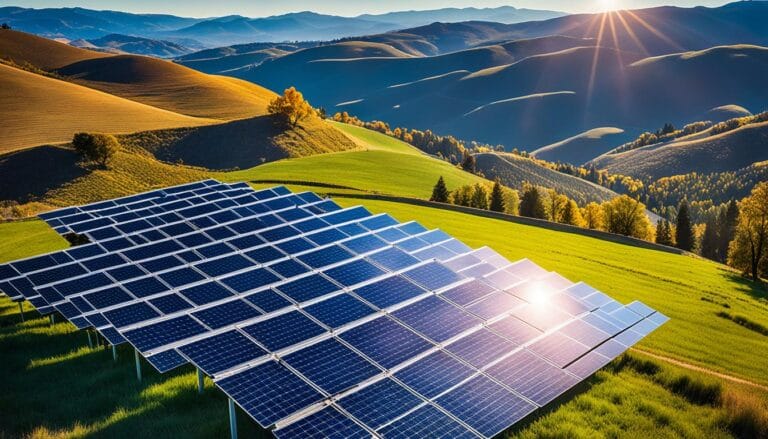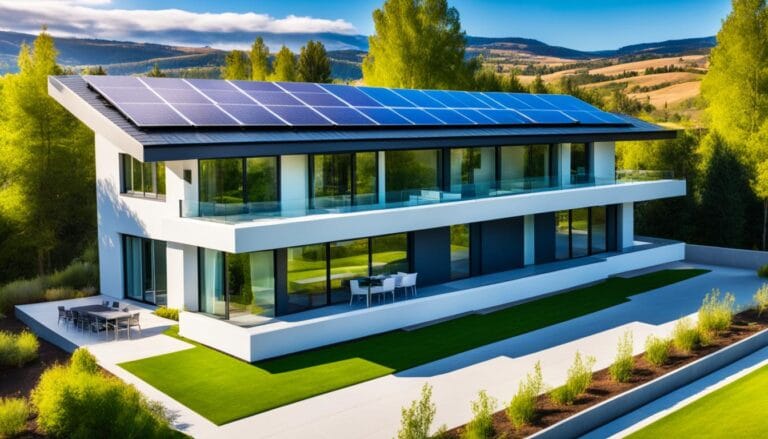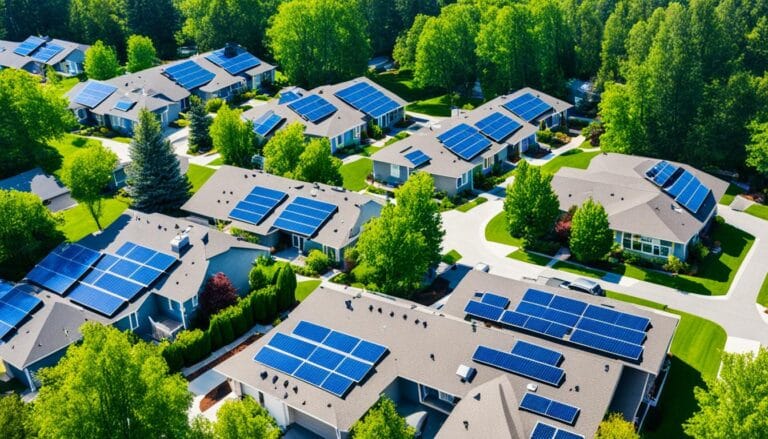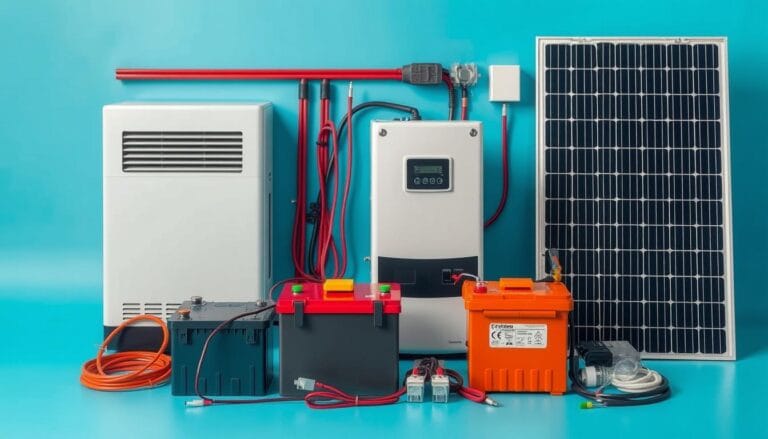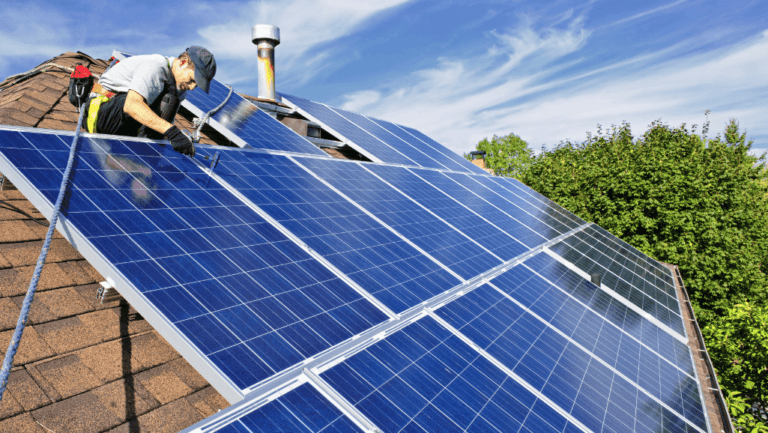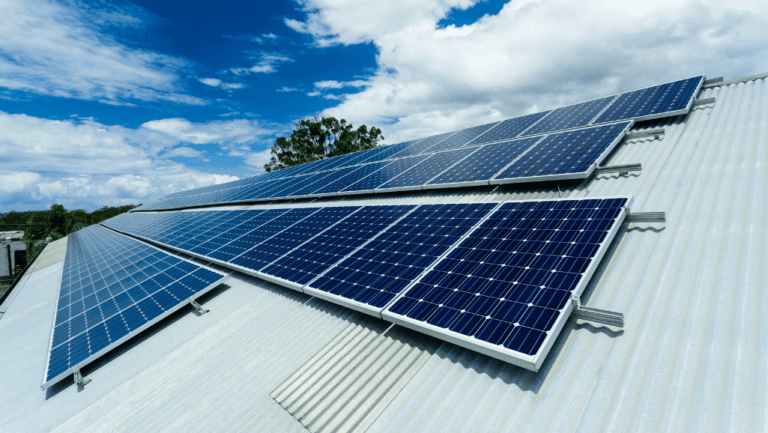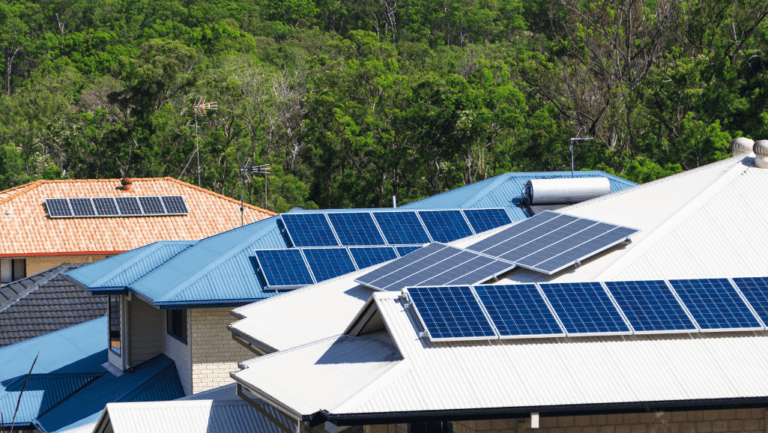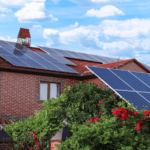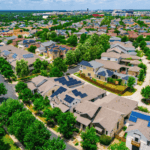Homeowners are looking for ways to use less energy and be kinder to the planet. They’re turning to the sun for power. The market is full of best rated solar panels that aim to be the most efficient. People read solar panel reviews and look at best solar panel companies to find a good deal. They want to cut their energy bills and reduce their carbon footprint with the latest in sustainable technology from top solar panel brands.
Key Takeaways
- Selecting from the best rated solar panels ensures optimal energy efficiency for home use.
- Top solar panel brands offer diverse options balancing cost and performance to meet specific needs.
- Expert solar panel reviews favor panels with higher efficiencies and longer warranties.
- Best solar panel companies prioritize advancements in technology for increased sustainability.
- Cost and efficiency metrics are crucial to evaluate the true value provided by solar panel systems.
- Monocrystalline technology remains the standard for efficiency in solar cell designs.
- Increased panel efficiency means more energy generation in less space, optimizing rooftop real estate.
Unveiling the Maxeon 7: The Pinnacle of Solar Panel Efficiency
https://www.youtube.com/watch?v=bNCzCwbaqmM
The search for the highest efficiency solar panels has reached a big milestone with the Maxeon 7. This panel is known for its efficiency over 24%, setting a new standard. It’s a big step forward in solar technology. The Maxeon 7 doesn’t just perform well; it fits perfectly into top rated solar energy systems.
Pioneering Performance: Maxeon’s Leap in Efficiency
Maxeon Solar Technologies is a leader in solar innovation, and the Maxeon 7 is a prime example. It has the world’s highest efficiency at 24.1%. These panels are made to last, with a yearly power loss of just 0.25%. This means they keep working well for a long time, saving money on energy costs. For more on how these panels work, check out this article on solar panel efficiency.
Europe Leads with Early Access: Awaiting Maxeon 7 in America
Right now, the Maxeon 7 is only available in Europe, but it will come to other areas by the third quarter of 2024. This early start lets European homeowners be the first to use the latest in solar technology. Everyone in the U.S. is looking forward to getting these top rated solar energy systems for their homes.
| Panel Model | Efficiency | Average Cost (per watt) | Performance Warranty |
|---|---|---|---|
| Maxeon 7 | 24.1% | >$3.00 | 88.3% after 40 years |
| Panasonic | 22.2% | $2.61 – $3.45 | 92% after 25 years |
| Jinko Solar | >22% | $2.60 | 83.1% after 30 years |
| Qcells | ~21% | as low as $2.32 | 86% after 25 years |
This solar panel comparison shows the tech and cost factors to think about when picking panels. The Maxeon 7 is not just the best in efficiency but also has the longest warranty, promising long-term value and dependability.
The Intricacies of Solar Panel Efficiency
Improving solar panel efficiency has led to big tech advances and lots of research. It’s not just about picking the right panels. It’s about understanding materials, technology, and how panels work in real life.
Solar technology has made huge strides in panel efficiency. For example, most recommended solar panels like monocrystalline ones now have efficiency over 20%. Polycrystalline panels are usually 13-16% efficient. So, if you need high efficiency, go for monocrystalline panels.
| Year | Efficiency | Panel Type |
|---|---|---|
| 1954 | 6% | Early Models |
| 1960 | 14% | Early Models |
| 2014 | > 40% | UNSW Developments |
| 2019 | 47.1% | NREL Record |
These numbers show how far solar panels have come. They also hint at future progress, like perovskite solar cells. Experts think these cells could beat traditional silicon ones, making them very interesting for the future of trusted solar panel reviews.
Recently, solar cells have gotten about 8% better, from 15% to 23%. This means a 250W panel now does more work than before. It also means you need less space for solar panels, making solar energy more appealing for homes and businesses.
As solar technology gets better, it’s important to look at more than just efficiency. Consider how durable a panel is, its warranty, and the company behind it. Reading trusted solar panel reviews can help you make a smart choice for your solar energy needs.
2024’s Most Efficient Residential Solar Panels Revealed
2024 is a big year for solar energy. Solar technology has made huge strides, making solar panels a common sight. They’re now leading the way in energy efficiency. This year, solar panel ratings and reviews show a big jump in their performance.
From Lab to Roof: Real-World Metrics for Today’s Solar Technology
From lab tests to real homes, solar panels have made great strides. Over half of solar panels in the U.S. now hit 20% efficiency or more. This was a big goal just a few years back. Monocrystalline panels, known for their high efficiency, top the list of top solar panels for residential use.
Companies like LG, Maxeon, and Silfab are leading with their advanced monocrystalline panels. LG’s efficiency is at 22.30%, Maxeon at 22.80%, and Silfab at 21.40%. These numbers show the tech progress and help homeowners save on bills and the environment.
Industry Benchmarks: Over 20% Efficiency Becomes the Norm
Efficiency standards have risen over time. With more focus on the environment and efficient energy, companies are innovating. It’s key for those looking at solar panels to check out the latest best rated solar panels 2021 and 2022 for their needs.
Panel type, build, and installation location affect solar panel performance. South-facing roofs are best for catching sunlight, which is key for efficiency.
High-efficiency solar solutions meet today’s energy needs and support long-term sustainability. The move to solar energy, with its constant tech improvements and high standards, matches the world’s shift to renewable energy. This sets a green path for the future.
As we move into 2024, it’s clear that ultra-efficient solar panels are here to stay. They’re changing how we use solar energy, making it more accessible, reliable, and efficient than ever.
Best Rated Solar Panels: Balancing Cost, Aesthetics, and Efficiency
Choosing the right top quality solar panels is tricky. Homeowners must weigh cost, looks, and how well they work. It’s not just about how they perform under the sun. It’s also about how they look on a home.
| Brand | Max Power Output | Efficiency | Warranty |
|---|---|---|---|
| SunPower | 440w | 23% | 25 years |
| Longi | 450w | 20.7% | 30 years |
| Hanwha Q Cells | 485w | 21% | 25 years |
| Canadian Solar | 540w | 21% | 25 years |
| Trina Solar | 480w | 20.1% | 25 years |
High-efficiency panels from brands like SunPower are tempting. But, they can be pricey. For those looking for value, Longi or Canadian Solar offer great performance at a lower cost.
- The best solar panels for home use not only perform well but also look good. They keep a home looking nice.
- Solar panel reviews show more people want panels that look good. Options range from all-black to SolarSkin technology by Sistine Solar.
As technology gets better, stylish and efficient solar panels become more affordable. Now, homeowners can pick high-performance panels that are also cost-effective. This lets them go green without spending a lot or sacrificing style.
Choosing the right solar panel means finding the best mix of solar panel reviews, efficiency, and looks. This way, the chosen panels help the environment and make the homeowner happy.
Factors Impacting the Real-World Efficiency of Solar Panels
Solar panels work better than just their specs suggest, thanks to many environmental and situation factors. Knowing these factors is key to getting the most energy and picking the right solar solutions for your area.
Understanding How Environmental Conditions Influence Performance
Many environmental factors affect how well solar power systems work. High heat can make solar panels less efficient. On the other hand, cooler weather helps them work better, with the best temperature around 25°C (77°F).
Snow and ice can also lower output a lot, stopping energy production if it’s heavy. Shading from buildings or trees can cut energy too, showing why sunlight access is crucial for solar panels.
Optimal Solar Panel Placement for Maximized Energy Harvest
Putting solar panels in the right spot is key for good performance. They should face south in the Northern Hemisphere to get the most sun. The tilt of the panels should match the location’s latitude for the best sunlight angle all year.
Smart placement and regular upkeep, like cleaning and checking for damage, boost panel performance and life. Thinking about these things when designing and setting up solar panels makes them work better and pay off more.
Using top-notch inverters and durable panels helps avoid losses from electrical resistance and wear. That’s why many choose solar panel services that offer setup and maintenance advice.
The table below shows how different setups affect solar panel performance:
| Condition | Effect on Efficiency | Adjustment for Optimal Performance |
|---|---|---|
| Temperature > 25°C | Decrease by up to 0.5% per degree | Installation in cooler, ventilated areas or using cooling systems |
| Partial Shading | Output reduction by 10-25% | Strategic panel placement away from potential shade sources |
| Snow/Ice Coverage | Complete halt (100% loss) with heavy accumulation | Installing automated cleaning systems or tilted panels for natural cleaning |
Using these strategies for solar panel setups boosts energy production and makes solar energy last longer. As solar tech gets better, knowing and using these tips is key to getting the most from solar power.
Comparative Analysis: Monocrystalline vs. Polycrystalline vs. Thin-film Panels
It’s important to know the differences between monocrystalline, polycrystalline, and thin-film solar panels. This comparison will look at efficiency, cost, and looks.
The Advantages of Monocrystalline Silicon in Premium Solar Panels
Monocrystalline solar panels are known for their high efficiency and power. They can reach up to 375 watts or more, perfect for small spaces. These panels work well in low light and are sleek, making them a good choice for looks.
Cost-Effectiveness of Polycrystalline Solar Panels
Polycrystalline panels are a bit less efficient but cheaper upfront. They cost about $0.05 more per watt than monocrystalline panels. These panels need more space and have a blue look. They’re great for big installations where looks don’t matter as much.
When choosing between monocrystalline, polycrystalline, and thin-film panels, think about your energy needs. Consider efficiency, cost, and space to find the best fit.
The Evolution of Solar Panel Technology and Its Impact on Efficiency
The rise of solar panel technology advancements has changed renewable energy a lot. Each new technology leap makes solar power better and cheaper. This is good news for both people using solar power and companies making it.
Perovskite cell technology is a big deal because it could change future solar energy systems. It’s getting better along with other top solar panels, leading to more efficient solar power.
Breakthroughs in Photovoltaic Technology and Future Trends
The story of solar panels is one of big steps forward. From early days with low efficiency to today’s advanced systems, solar tech has grown a lot. This growth hints at even more exciting changes ahead.
How Perovskite Cell Technology Might Change the Game
Perovskite cell technology is getting a lot of attention for its great light absorption and efficiency. With more engineering and material science, it could soon offer unmatched efficiency. This could change the solar market a lot.
Thanks to these new technologies, solar energy is getting cheaper. Swanson’s Law says solar module costs go down by 20% every time production doubles. This makes solar power more affordable for more people.
| Year | Efficiency | Cost per Watt |
|---|---|---|
| 1954 | 4% | $300 |
| 1975 | 10% | $100 |
| 1999 | 33.3% | $4 |
| 2016 | 34.5% | $0.70 |
| 2024 | Up to 24% | $2.41 – $3.66 |
Looking forward, perovskite cell technology and other advancements will keep making solar power a key part of our green future. The solar industry is set to get even better, offering more efficient and affordable solar solutions for many uses.
Exploring the Top Solar Panel Brands for Your Home
Choosing the right solar panel brand is key to saving energy and being eco-friendly at home. With many options out there, it’s important to know which ones stand out. This section looks at leaders like SunPower, Jinko Solar, and Canadian Solar. We’ll see what makes their products great for homes.
SunPower’s M-Series: Leading the Charge with High Performance
SunPower is known for its efficient and long-lasting solar panels. The M-Series is a top pick for those with limited roof space. It’s designed for high performance in small areas. SunPower solar panels are a top choice for their efficiency and reliability.
Comprehensive Warranty and Reliability: What to Look For
When buying solar tech, the warranty and reliability are as important as how well it works right now. Jinko Solar and Canadian Solar offer strong warranties that show their panels last a long time. Canadian Solar, for example, guarantees their panels for 30 years with only a 0.35% drop in performance each year.
Looking at best solar panel reviews helps buyers make a smart choice. These reviews share real-life experiences and expert advice. They highlight how well different brands work and install, which is key to picking the right solar system.
New trends like TOPCon technology and making panels in the US are exciting. They make panels work better and help the planet by cutting down on carbon emissions during production and shipping.
In the end, picking the best brand means looking at efficiency, warranty, cost, and reliability. With the solar market always changing, choosing brands with great reviews and a solid reputation is smart. This way, your investment will pay off in the long run.
Understanding the Role of Panel and Cell Efficiency in Solar Panel Selection
When picking high-quality solar panels, it’s key to look at solar panel efficiency rates. This rate shows how well photovoltaic panels turn sunlight into electricity. It’s a big factor in how well solar power systems work.
Monocrystalline silicon panels are top-notch, often over 20% efficient. They’re perfect for places where space is tight, like homes or businesses. On the other hand, polycrystalline silicon panels are cheaper but less efficient, around 15-20%. They’re better for big areas.
Thin-film technology used to be less efficient but has gotten better. Now, with new materials like perovskite, it’s almost as good as silicon panels.
| Type of Panel | Average Efficiency | Cost per Watt | Typical power output | Best Use Scenarios |
|---|---|---|---|---|
| Monocrystalline Silicon | 20%+ | $2.85 | 11,000 kWh yearly from 7.4 kW system | High efficiency in limited spaces |
| Polycrystalline Silicon | <20% | $2.85 | 9,000 kWh yearly from 6 kW system | Cost-effective for large spaces |
| Thin-Film (with Perovskite) | Matches silicon cells | $2.85 | Varies with technology advancements | Lightweight adaptive uses |
It’s important to know how different panels work together. For example, monocrystalline panels keep their efficiency well in heat. But, they cost more at first. Still, they save more energy over time and might get tax credits.
Keeping solar panels working well means cleaning them and placing them right. Pros use software to find the best spot for the sun. Each panel’s efficiency helps the whole system work better. So, picking the right panel is key for your power needs and location.
New tech in photovoltaic technology has made solar power better. Choosing the right, strong, and high-quality solar panels is more important than ever. They’re the base of a good solar setup, saving money on energy for a long time.
Conclusion
Homeowners have many advanced options for using the sun’s energy. The SunPower Maxeon is a top choice with a 22.8% efficiency rate. Other options like polycrystalline and thin-film also have their benefits. Choosing the best solar panels means supporting sustainable living and being energy independent.
When picking solar panels, look at their lifespan, reliability, and support after purchase. SunPower offers a 25-year warranty and high scores on EnergySage, showing their commitment to customers. With costs around $3.61 per watt and tax credits, solar power is getting more affordable.
New tech like Perovskite cells could bring even better efficiency soon. For now, homeowners can trust leading brands for reliable solar setups. These systems offer energy and peace of mind with strong warranties and expert help. Solar energy is key to modern, eco-friendly living.







